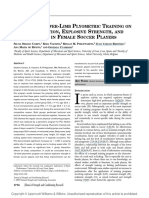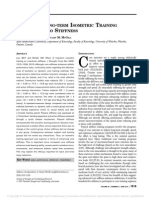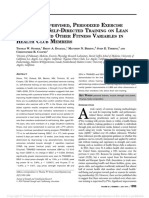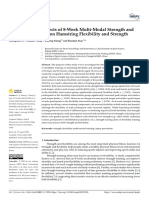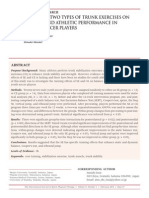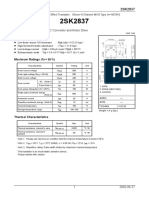Journal of Human Kinetics volume 91/2024, 19–31
DOI: 10.5114/jhk/184042
19
Modern strategies to support health, fitness and sports training
1
Center for Sport Performance, Department of Kinesiology, California State University, Fullerton, Fullerton, CA, USA.
2
School of Kinesiology, Applied Health and Recreation, Oklahoma State University, Stillwater, OK, USA.
3
Tactical Fitness and Nutrition Lab, Oklahoma State University, Stillwater, OK, USA.
* Correspondence: rlockie@fullerton.edu
Strength Training Frequency and Athletic Performance in High School Girls Basketball Players
by Erika Viramontes
1
, J. Jay Dawes
2,3
, Jared W. Coburn
1
, Robert G. Lockie
1,
*
This study investigated the effects of a six-week strength training intervention on the physical fitness of female high school athletes, with a focus on training frequency. Twenty-three female high school basketball athletes were recruited and split into two groups: one group participated in strength training once per week (S1), while the other participated in two training sessions per week (S2). The groups were not random as training sessions were voluntary, and some participants were only able to train once per week. Participants were tested before and after the intervention, and the data included: age, body height, body mass, body fat percentage, grip strength, leg/back dynamometer (LBD) strength, a seated medicine ball throw (MBT), a vertical jump (VJ), 505 tests from each foot, 0–5, 0–10, and 0–20 sprint times, and multistage fitness test shuttles. Data were analyzed by a two (time) x two (group) repeated measures analysis of variance (ANOVA; p < 0.05). When significant F ratios were detected in any ANOVA calculations, post hoc pairwise comparisons were conducted using the Bonferroni adjustment procedure. There were significant main effects for time that indicated the following: increased body height, body mass, grip strength, LBD strength, MBT distance, and VJ height, faster 505 times, and slower 0–5 and 0–10 m sprint times (p
≤
0.021). There were no significant time by group ANOVAs or between- group main effects. These performance changes occurred irrespective of training frequency. High school girls who participate in at least one strength training session per week can improve their strength (grip, LBD), power (MBT, VJ), and change-of-direction speed (505).
Keywords
: adolescents; change-of-direction speed; female athletes; power; resistance training
Introduction
Organized sports participation can benefit youth development, including fewer behavior problems, increased educational achievement, and better psychosocial adjustment (Linver et al., 2009). High school sports participation is also associated with improved adult lifestyle habits and cardiovascular fitness (Angeli et al., 2017). What can supplement success in high school sports is the addition of resistance training in the preparation of athletes (Behm et al., 2008). Resistance training has been recommended for youth by various professional associations (Behm et al., 2008; Faigenbaum et al., 2009). When performed with proper technique, resistance training has the potential to decrease the incidence and severity of injuries and improve athletic performance in young athletes (Behm et al., 2008). Increases in muscular strength and endurance, bone mineral density, motor coordination, maintenance of a healthy body weight, decreased body fat, and decreased depression are all potential benefits of strength training (Barahona-Fuentes et al., 2021; Dahab and McCambridge, 2009; Krolikowska et al., 2023; Miko
ƚ
ajec et al., 2017;
Papla et al., 2022; Spieszny and Zubik, 2018;). To provide specific examples, a higher repetition-moderate load resistance training program in children from 5 to 12 years of age increased muscle strength and endurance

20
Strength training frequency and athletic performance in high school girls basketball players
Journal of Human Kinetics, volume 91, March 2024 http://www.johk.pl
(Faigenbaum et al., 1999). The training groups participated in twice-weekly resistance training programs, which included either a lower repetition-higher load intervention or a higher repetition-moderate load intervention, for eight weeks. There was a 31–41% increase in a one repetition-maximum (1RM) leg extension, and a significant increase in leg extension muscular endurance, for both exercise groups. Findings from another study with 18 soccer players aged 12–15 years suggested that the addition of a resistance training program, in accompaniment with soccer training, could increase upper- and lower-body strength, and aid in physical development (Christou et al., 2006). The players followed a soccer-specific training program five times per week, with two specific groups; one completing the soccer program, and the other participating in the soccer program with the addition of strength training. The 16-week strength program involved two sessions a week and was programmed for 10 exercises, at 2–3 sets of 8–15 repetitions, with a load of 55–80% 1RM. After the training period, the group who completed the strength training program showed superior improvement in upper- and lower-body maximal strength (measured by a 1RM bench press and leg press, respectively), vertical jump height, and 30-meter (m) sprint speed (Christou et al., 2006). High school-level athletes, however, can have different experiences based on school they attend. The program budget can dictate the quality and quantity of high school sports coaches, training facilities, team and athlete expenses, and the caliber of strength and conditioning programs offered to student-athletes. Despite the Title IX Educational Amendment 1972, which prohibited sex discrimination in any education program or activity receiving federal financial assistance in the USA, there is an imbalance in what females are afforded in the sporting environment (Silvers-Granelli, 2021).
This includes diminished access to exercise equipment, lower coaching standards, medical staffing, and strength and conditioning programs (Parsons et al., 2021; Silvers-Granelli, 2021). If a school does not have a designated certified strength and conditioning coach on staff, the responsibility of providing programs usually lies on the head coaches of their respective sport (Reynolds et al., 2012). The quality of strength and conditioning programs provided to students could be greatly affected in such situations. Indeed, strength and conditioning programs at the high school level may not be implemented by someone who is educated in best practices. One survey conducted by Reynolds et al. (2012) with coaches of girls’ and boys’ baseball/softball, basketball and soccer, found that most of the strength and conditioning programs were delivered and executed by coaches without some sort of personal trainer or strength and conditioning certification. Despite only a select handful of coaches being considered “certified” strength and conditioning coaches, a large percentage were interested in obtaining certifications and enhanced education. This suggests that coaches are aware of their lack of formal knowledge and the need to learn. What could support teachers pursuing further education is research demonstrating the value of strength and conditioning programs provided by professionals trained specifically in strength and conditioning. This is important in situations where athletes may have limited time to train, and need to make the most of what time they have available for resistance training. This study compared the effects of participation in a structured 6-week strength training program, provided by strength and conditioning coaches, on the physical fitness of female high school athletes. Part of the sample participated in one session per week, while the rest of the sample participated in two sessions per week. The intent of this study was to demonstrate the potential impact of certified and experienced strength and conditioning professionals in helping prepare athletes at the high school level. Furthermore, this study also aimed to investigate whether one or two training sessions per week created similar results. It was hypothesized that athletes participating in the strength training program twice per week would demonstrate greater fitness improvements than athletes who participated only once per week.
Methods
Participants
Participants were recruited from one high school located in southern California. A total of 27 female high school athletes were available for this study (age: 15.22 ± 0.95 years; body height: 162 ± 8.07 cm; body mass: 61.52 ± 14.23 kg). Inclusion
by Erika Viramontes et al.
21
Articles published in the Journal of Human Kinetics are licensed under an open access Creative Commons CC BY 4.0 license.
criteria comprised being part of the girls’ high school basketball team and participation in both pre- and post-testing. There were no athletes above the age of 18. Thus, before testing took place, parents signed a consent form to allow their children to participate in this study. Student-athletes signed their respective assent forms on the day of their first testing session. The procedures used in this study were approved by the Institutional Review Board of California State University, Fullerton (approval code: HSR-19-20-511; approval date: 15 June 2020).
Procedures
The study was conducted during March–May in the Spring semester, which was the basketball off-season. All tests were completed within a two-hour session at the high school in the afternoon. If participants could not attend the original pre- and post-testing session, they completed a make-up session within three days of the original date. Age was recorded prior to testing. Body height of each participant was measured via a stadiometer (Health O Meter, Ontario, Canada) in centimeters (cm). The final selection of other tests was determined in consultation with the high school coaches. Athletes were tested before and after their participation in the strength training intervention. The test order was determined based on which ones would be least fatiguing being completed first, to those that would be most taxing completed last (McGuigan, 2015), in addition to the logistics of the testing location at the high school.
Body Mass and Body Fat Percentage
Electronic digital scales (Model HBF-510, Omron Healthcare, Kyoto, Japan), which include bioelectrical impedance analysis, were used to record body mass and body fat percentage (BF%). While it was difficult to control for hydration, participants were instructed to maintain their typical diet and fluid intake prior to testing. Protocol guidelines provided from the manufacturer were followed to record BF% (Vasold et al., 2019). The participant’s age, body height in cm, and sex were entered into the device. The participant was not wearing shoes or socks when on the scale. They stepped onto the scale with their feet positioned on the foot and heel electrodes before holding the display unit with both hands until their body mass was displayed on the screen. The display unit also had electrodes on the handles, and the hands were positioned on top of these electrodes. Once the participant’s feet and hands were positioned on the appropriate electrodes (eight in total), they were told to stand upright and extend their arms, so that they were parallel to the ground. Equations from the device provided measurements of their body mass and BF%.
Grip Strength
Grip strength provides a measure of upper-body strength and has been used to assess strength in adolescents (Hager-Ross and Rosblad, 2002), and was measured via a dynamometer (Takei Scientific Instruments, Japan). Participants kept their testing arm by their side throughout the assessment and squeezed the handle as hard as possible for approximately 2–3 s. Three trials for each hand were recorded to the nearest kg, with the best trial for each hand summed together to provide the grip strength metric.
Leg/Back Dynamometer
Leg and back strength were measured using a leg/back dynamometer (LBD) (Fabrication Enterprises, Inc., New York, USA). This test provides a valid measure of lower-body strength and can be performed safely by those with a limited training background (Dawes et al., 2017). The participant was positioned so that her arms were extended and both hands were on the handle positioned at the mid-thigh (knee flexion angle of ~110°). From here, participants pulled up on the handle as hard as possible by attempting to extend the hips and knees. Three attempts were given, with the best trial being analyzed.
Seated Medicine Ball Throw
Upper-body power was measured with a seated medicine ball-throw (MBT) (Lockie et al., 2018). Participants sat against a wall and projected a 4.5-kg medicine ball (Champion Barbell, Texas, USA) as far forwards as possible using a two-handed chest pass. The measurement was taken using a standard tape measure and was the perpendicular distance from the wall to where the ball contacted the ground. Three trials were completed, with a between-trials recovery time of ~60 s. The best trial was analyzed.
22
Strength training frequency and athletic performance in high school girls basketball players
Journal of Human Kinetics, volume 91, March 2024 http://www.johk.pl
Vertical Jump
The vertical jump (VJ) test was used to indirectly measure lower-body power (Lockie et al., 2014a, 2014b), and a jump mat (Just Jump, Probotics Inc., Huntsville) measured performance (McFarland et al., 2016). The participant stood on the mat keeping her heels on the floor, before completing a countermovement with an arm swing and jumping as high as possible. Participants were instructed to maintain straight legs during the flight, before landing on both feet with flexion of the hips, knees, and ankles. Within the software for the mat, jump height was calculated in inches and converted to cm. Each participant completed three trials, with ~60 s between trials, with the best trial used for analysis.
20-m Sprint
A 20-m sprint measured maximal running speed with procedures adapted from previous research (Post et al., 2022). Timing gates (Dashr Motion Performance Systems, Nebraska, USA) were positioned at 0 m, 5 m, 10 m, and 20 m, to measure the 0–5 m, 0–10 m, and 0–20 m intervals. Gate height was set at 0.93 m, and gates were positioned 2.4 m apart. Participants began each sprint from a standing start 50 cm behind the start line to trigger the first gate. Three trials were completed with time recorded to the nearest 0.01 s, and the best 20-m sprint trial was analyzed.
505 Change-of-Direction Speed Test
The 505 test measured change-of-direction (COD) speed (Post et al., 2022). This test required the participant to sprint 10 m past a timing gate (Dashr Motion Performance Systems, Nebraska, USA), then keep sprinting for another 5 m, before planting her foot on the turning line (15 m from the start line), turning back 180° to run past the timing gate. Participants completed three trials per foot (e.g., left-foot plant and turn, and right-foot plant and turn). For consistency, all participants planted with their left foot first for three trials, then planted with their right foot for three trials. The best trial for each foot was used for analysis.
Multistage Fitness Test
The multistage fitness test (MSFT) measured maximal aerobic capacity (Lockie et al., 2020). Participants ran back and forth in an indoor gym, between two lines spaced 20 m apart indicated and marked on the ground with tape and cones. Running speed was standardized by pre-recorded auditory cues (i.e., beeps) played from an iPad handheld device (Apple Inc., Cupertino, California) connected via Bluetooth to a portable speaker (JBL FLIP 5, Los Angeles, CA), which was placed in the center of the running area. The test was terminated when the participant was unable to reach the lines twice in a row in accordance with the auditory cues, or by voluntary exhaustion. This test was scored according to the final stage and level the participant, which were used to calculate the total number of completed shuttles.
Resistance Training Program
The training program was designed specifically to focus on muscular strength and hypertrophy. Programming guidelines for high school athletes were followed (Faigenbaum et al., 2009; Sheppard and Triplett, 2016). The program was designed with the team’s availability in mind (i.e., two sessions per week). Training sessions were not mandatory and were offered from 4–6 pm twice a week, on Mondays and Fridays. Participants could attend either one or both sessions, and could attend any training day (i.e., Monday or Friday). However, there were participants who could only attend one session per week because of outside commitments (e.g., club basketball), and the day participants did attend may have varied (i.e., some could only attend Monday, others only on Friday). This meant the exact load experienced by participants across their training was difficult, if not impossible, to track. Nevertheless, attendance was noted for all participants who completed the training program. Participants were placed into groups after the intervention based on their attendance and were not randomly allocated. Two coaches contributed to the prescription of the strength and conditioning program, and there was one coach at every training session. One of the coaches had obtained their bachelor’s degree in Kinesiology and was currently pursuing a master’s degree in Kinesiology as well. They also had their National Strength and Conditioning Association Certified Strength and Conditioning Specialist (CSCS) certification and had two years of experience coaching high school athletes and adults. The second coach had a bachelor’s degree in Kinesiology, and more than five years of experience coaching high school






















